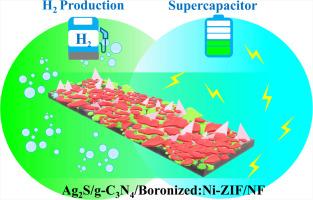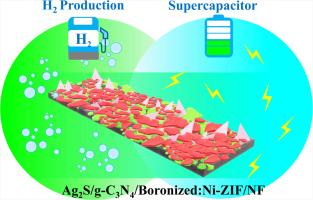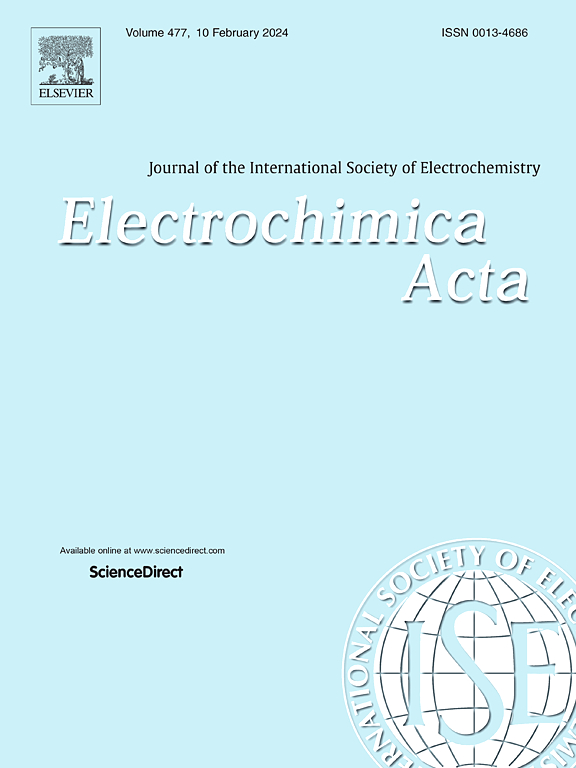Intercalation of g-C3N4/Ag2S heterostructure on boronized Ni-MOF for enhanced water splitting and energy storage applications
IF 5.5
3区 材料科学
Q1 ELECTROCHEMISTRY
引用次数: 0
Abstract
The increasing global demand for energy conversion and storage technologies including water electrolysis, fuel cells, batteries & supercapacitors depend critically on the performance of their electrode components. Metal Organic Frameworks (MOFs), particularly Nickel Zeolite Imidazole Frameworks (Ni-ZIF) have drawn significant attention due to their greater electrocatalytic performance. Still, their restricted active sites & stability hinder their broader implementation in alkaline/saline water electrolysis & supercapacitor applications. Here, we are reporting the intercalation of heterostructure consisting of silver sulfide (Ag2S)/graphitic carbon nitride (g-C3N4) on Boronized Ni-ZIF (B:NZ) for empowered alkaline/saline water splitting and supercapacitor applications. These heterostructure addition over Boronized Ni-ZIF demonstrated minimal overpotentials for the oxygen evolution reaction (OER) (324 mV at 10.0 mA cm-2) and the hydrogen evolution reaction (HER) (78 mV at 10.0 mA cm-2) in alkaline medium (1 M KOH). The observed improvement in activity is ascribed to the decreased charge transfer resistance (Rct) & the augmented electrochemical active surface area (ECSA). Furthermore, Ag2S/g-C3N4/Boronized Ni-ZIF exhibited high specific capacitances of 1076.6 F/g and areal capacitance of 2584 F/cm2 at 0.50 A g-1 in supercapacitor applications. The incorporation of the g-C3N4 layer has enhanced the surface area and roughness facilitating stronger adhesion between hybrid layers which in turn resulted in prolonged stability exceeding 20 h in water splitting and 86 % retention in supercapacitor application.


在硼化 Ni-MOF 上夹杂 g-C3N4/Ag2S 异质结构以增强水分离和储能应用
全球对电解水、燃料电池、电池和超级电容器等能源转换和储存技术的需求日益增长,这主要取决于其电极元件的性能。金属有机框架(MOFs),尤其是镍沸石咪唑框架(Ni-ZIF)因其较高的电催化性能而备受关注。然而,它们有限的活性位点和稳定性阻碍了它们在碱性/盐水电解和超级电容器应用中的广泛应用。在此,我们报告了在硼化镍-ZIF(B:NZ)上插层硫化银(Ag2S)/石墨化氮化碳(g-C3N4)组成的异质结构,以增强碱性/盐水电解和超级电容器的应用。在碱性介质(1 M KOH)中,这些添加在硼化镍-ZIF 上的异质结构在氧进化反应(OER)(10.0 mA cm-2 时为 324 mV)和氢进化反应(HER)(10.0 mA cm-2 时为 78 mV)中的过电位极低。观察到的活性提高归因于电荷转移电阻(Rct)的降低和电化学活性表面积(ECSA)的增加。此外,在超级电容器应用中,Ag2S/g-C3N4/硼化镍-ZIF 在 0.50 A/g 时表现出 1076.6 F/g 的高比电容和 2584 F/cm2 的等面积电容。g-C3N4 层的加入增大了表面积和粗糙度,有利于增强混合层之间的粘合力,进而使其在分水应用中的稳定性超过 20 小时,在超级电容器应用中的保持率达到 86%。
本文章由计算机程序翻译,如有差异,请以英文原文为准。
求助全文
约1分钟内获得全文
求助全文
来源期刊

Electrochimica Acta
工程技术-电化学
CiteScore
11.30
自引率
6.10%
发文量
1634
审稿时长
41 days
期刊介绍:
Electrochimica Acta is an international journal. It is intended for the publication of both original work and reviews in the field of electrochemistry. Electrochemistry should be interpreted to mean any of the research fields covered by the Divisions of the International Society of Electrochemistry listed below, as well as emerging scientific domains covered by ISE New Topics Committee.
 求助内容:
求助内容: 应助结果提醒方式:
应助结果提醒方式:


